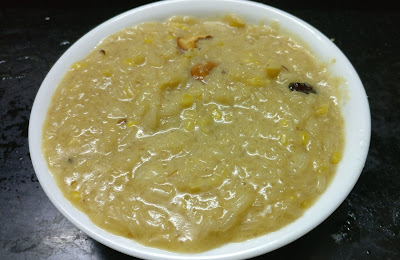Avial
Background
There is an amusing anecdote
about Avial. How it was invented by a chef, when his master, no less than The
King, had unexpected guests to feed. Growing up, Avial was a Sunday staple in
Amma’s kitchen. Avial has two variants. Sometimes she would make the watery variant,
which we would mix with steaming white rice. On other times when she made
chapatis, she would prepare the more viscous variety of Avial as a splendid accompaniment.
It is this latter version that is served with great pride in the spectacular
sadhya spread of Kerala.
Irrespective of the variant, the
vegetables that go into Avial are the same. The apocryphal anecdote will have
us believe that any leftover vegetable can be sneaked into Avial. I disagree.
There are only 7 vegetables that can used for preparing the Avial, out of which
3 are mandatory – Ash Gourd, Raw Plantain, and Yam. The other 4 optional
vegetables are Pumpkin, Snake Gourd, Carrot and Drumstick.
Avial is extremely easy to
prepare. There are four key features of a well-made Avial.
1) Tanginess.
Avial derives its tanginess from the curd added right towards the end. It is
important to add a curd that is a bit sourer than normal.
2) Texture.
Avial gets its texture from the coconut. A generous quantity of coconut paste
has to be weaved into the preparation.
3) Aesthetics.
This is probably the most important characteristic of the Avial. The vegetables
have to be uniformly chopped in rectangular strips about two-thirds of the length
of the index finger. The contrasting colours also contribute to the overall
aesthetics – the red of the carrot, the white of the ash gourd, the pale yellow
of pumpkin and yam and the pale green of the snake gourd. It is equally important
to add only a pinch of turmeric powder.
4) The
fragrance. This is of course, defined by the dollop of coconut oil added at the
very end.
Ingredients
Yam – 100 g
Ash Gourd – 100 g
Raw Plantain – 1
Pumpkin – 100 g
Carrot – 100g
Snake Gourd – 100 g
Drumstick – 1 or 2
Sour Curd – 1 bowl
Coconut shredded – half cup
Green Chilli – 1 or 2
Cumin 1 tsp (optional)
Coconut oil
The vegetables mentioned above
should be in more or less equal proportion except for the drumstick.
Method
1) Chop the vegetables
uniformly into strips about two-thirds length of the index finger.
2) Make a paste
from the shredded coconut, green chilli and cumin (optional) and set it aside.
3) Beat the curd
with a small amount of water till it flows freely. Keep it aside. If taken out
from the fridge, it should be brought up to the room temperature.
4) Cook the
vegetables thoroughly in minimum amount of water in a kadai. Keep adding water
to make up for the loss. Add salt to taste. Add just a pinch of turmeric powder.
The Avial should not be a dominating yellow.
5) When the vegetables
have cooked well, mix in the coconut paste. The quantity of water can be
adjusted at this juncture if you need the watery variant.
6) Bring it to boil
and reduce the flame.
7) Add the curd rapidly into the kadai while simultaneously stirring. The trick is not to allow the avial to boil after the curd has been added. Switch off heating the moment you spot the first bubble.
8) Finally add a dollop of coconut oil to the Avial.





Comments
Post a Comment